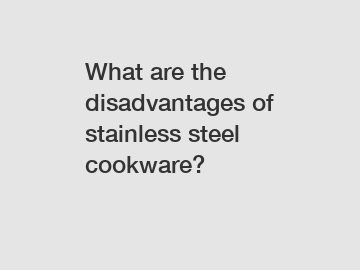Dec. 28, 2023
Home & Garden
What are the disadvantages of stainless steel cookware?
Stainless steel cookware has long been a favorite among home cooks and professional chefs alike. It is known for its durability, even heat distribution, and resistance to corrosion. However, like any other material, stainless steel cookware also has its fair share of disadvantages. In this article, we will explore some of the drawbacks associated with using stainless steel cookware.
1. Poor heat conductivity: While stainless steel is renowned for its durability, it is not the best conductor of heat. Compared to copper or aluminum cookware, stainless steel takes longer to heat up and cool down. This can result in uneven cooking, with certain areas of the pan being hotter than others. To combat this issue, many stainless steel pans now come with an aluminum or copper core, which helps improve heat conductivity.

2. Prone to food sticking: Unlike non-stick cookware, stainless steel has a tendency to stick, making it necessary to use oil or butter to prevent food from adhering to the surface. Even with the use of oil, certain foods like eggs or delicate fish can still pose a challenge when it comes to flipping or removing them from the pan without leaving a mess behind. Proper preheating and sufficient oil can help alleviate this problem to some extent.
3. Development of hot spots: Another disadvantage of stainless steel cookware is the development of hot spots. This occurs when the heat is not evenly distributed across the surface of the pan, leading to certain areas becoming much hotter than others. Hot spots can result in uneven cooking and may require frequent stirring or rotating of the food to ensure proper heat distribution.
4. Reactivity with certain foods: Stainless steel is made up of various metals, including nickel and chromium. While these metals make stainless steel corrosion-resistant, they can react with certain acidic or alkaline foods, resulting in a metallic taste. This can be particularly concerning for individuals with nickel allergies or those who have medical conditions that require them to avoid specific metals in their diet.
5. Requires careful cleaning and maintenance: Although stainless steel is relatively easy to clean, it does require some extra care to maintain its luster. Food residue, particularly if burnt or stuck to the surface, can be challenging to remove. Harsh scrubbing pads or abrasive cleaners should be avoided as they can scratch the stainless steel and damage its appearance. Additionally, stainless steel cookware should be dried thoroughly after washing to prevent water spots or the development of rust.
In conclusion, while stainless steel cookware has many advantages, from its durability to its resistance to corrosion, there are also several disadvantages to consider. These include poor heat conductivity, the tendency for food to stick, the development of hot spots, reactivity with certain foods, and the need for careful cleaning and maintenance. Despite these drawbacks, stainless steel cookware remains a popular choice in kitchens around the world. Whether you choose to invest in stainless steel cookware or opt for other types depends on your personal preferences and cooking needs.
If you are looking for more details, kindly visit stainless steel asparagus steamer, wholesale commercial stainless steel cookware, flatware set suppliers.
Previous: Which is the Superior Choice: OEM Plant Pots or ODM Flower Planters?
Next: Ultimate Guide to Installing Fixed Knot Mesh Sheep Fence
If you are interested in sending in a Guest Blogger Submission,welcome to write for us!
All Comments ( 0 )